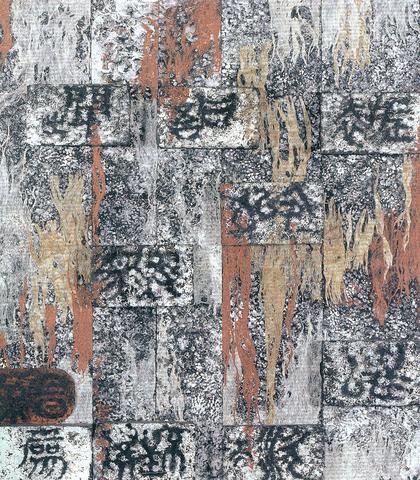In celebration of one China's most forward thinking artists and, as in the words of respected museum director, Huang Kuang-nan (黃光男), "to encourage creativity in art," Taipei's National Museum of History (國立歷史博物館) is holding a special exhibition of works by Tseng Yuho.
Entitled Images Collecting (意象綴集), the exhibition consists of 124 of Tseng's most innovative works from the last 50 years.
It's hard to imagine the soft-spoken, pensive and ever-cordial artist and calligrapher as a revolutionary these days. Now in her late 70s, Tseng has all the trappings of everyone's favorite granny and then some.

In her youth, however, both her father, her teachers and even many of her peers considered many of her ideas radical or even seditious.
Born in Beijing in 1925 to a literati family, Tseng's first inadvertent challenge to the age-old system took place in 1940, when she became one of the first Chinese women to be granted permission to enroll in Beijing's Fujen University (
Not that Tseng stopped there. In 1945 she did the unthinkable and married a non-Chinese, the eminent Sinologist, Gustav Ecke, who along with being a foreign national, was also German, a nation with which China was, theoretically at least, at war.

And as if all this wasn't enough to shock, Tseng set about re-writing the long accepted norms that governed the way in which generations of calligraphers had gone about their business when she began to blend traditional Chinese art practices with Western concepts.
Many believe that is was Tseng's highly unconventional lifestyle, as well her many journeys to foreign lands, that led her to become the pioneer of a style of art later dubbed "dsui" (掇) -- a word that means "to plagiarize." It is a rather an odd term for a style of art as unique as Tseng's.
Tseng and her husband moved to Hawaii in 1953, where she became the Asian art consultant at the Honolulu Academy of Arts -- a position she still holds today.
In addition to working as a creative artist, Tseng has also published countless papers and books dealing with Chinese art and calligraphy. The most important is A History of Chinese Calligraphy, which was published by The Chinese University Press in 1993 and is now considered the bible of calligraphy both by sinologists and students of Chinese art around the world.
The exhibition spans her work from the relatively conventional Seven Juniper Trees (七檜圖) painted in 1945 to recent work like Lines Wonder (筆妙), an abstract acrylic and aluminum piece. It also includes photographs and news-cuttings from Tseng's eventful life.
This combination makes the current exhibition much more than simply an art show. It is instead a celebration of a truly singular artist.
What: Images Collecting: An Exhibition of Tseng Yuho's Art Works (意象綴集 曾佑和作品展)
Where: National Museum of History, 49 Nanhai Rd.,Taipei (國立歷史博物館台北市南海路49號)
When: Until Dec. 2

June 9 to June 15 A photo of two men riding trendy high-wheel Penny-Farthing bicycles past a Qing Dynasty gate aptly captures the essence of Taipei in 1897 — a newly colonized city on the cusp of great change. The Japanese began making significant modifications to the cityscape in 1899, tearing down Qing-era structures, widening boulevards and installing Western-style infrastructure and buildings. The photographer, Minosuke Imamura, only spent a year in Taiwan as a cartographer for the governor-general’s office, but he left behind a treasure trove of 130 images showing life at the onset of Japanese rule, spanning July 1897 to

In an interview posted online by United Daily News (UDN) on May 26, current Chinese Nationalist Party (KMT) Chairman Eric Chu (朱立倫) was asked about Taichung Mayor Lu Shiow-yen (盧秀燕) replacing him as party chair. Though not yet officially running, by the customs of Taiwan politics, Lu has been signalling she is both running for party chair and to be the party’s 2028 presidential candidate. She told an international media outlet that she was considering a run. She also gave a speech in Keelung on national priorities and foreign affairs. For details, see the May 23 edition of this column,

The Taiwan People’s Party (TPP) on May 18 held a rally in Taichung to mark the anniversary of President William Lai’s (賴清德) inauguration on May 20. The title of the rally could be loosely translated to “May 18 recall fraudulent goods” (518退貨ㄌㄨㄚˋ!). Unlike in English, where the terms are the same, “recall” (退貨) in this context refers to product recalls due to damaged, defective or fraudulent merchandise, not the political recalls (罷免) currently dominating the headlines. I attended the rally to determine if the impression was correct that the TPP under party Chairman Huang Kuo-Chang (黃國昌) had little of a

At Computex 2025, Nvidia CEO Jensen Huang (黃仁勳) urged the government to subsidize AI. “All schools in Taiwan must integrate AI into their curricula,” he declared. A few months earlier, he said, “If I were a student today, I’d immediately start using tools like ChatGPT, Gemini Pro and Grok to learn, write and accelerate my thinking.” Huang sees the AI-bullet train leaving the station. And as one of its drivers, he’s worried about youth not getting on board — bad for their careers, and bad for his workforce. As a semiconductor supply-chain powerhouse and AI hub wannabe, Taiwan is seeing